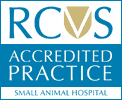We have two spacious fully equipped veterinary operating theatres catering for a variety of surgical cases that are seen here.

State of The Art Veterinary Operating Theatre/Suite
Here at Cave Veterinary Specialists, we have two dedicated, spacious fully equipped operating theatres where we treat a wide variety of cases ranging from soft tissue and orthopaedics through to neurological and interventional cardiology procedures.
Surgical patients treated by us are given the highest quality care during their stay with us and have full support from our anaesthetic team during their procedure. Being a multi-disciplinary practice, each patient also has access to support and expertise from internal medicine, oncology, dermatology, cardiology and neurology where needed.
The entire operating suite is designed to be minimalistic and only have the equipment required present in the rooms. Positive pressure filter ventilation ensures regular air changes occur in the theatre area and any dust and microbes from the adjoining prep room are directed out of the theatre suite.
The quality of care goes beyond surgical expertise and equipment and every aspect of patient comfort is thought about throughout their stay. Our dedicated wards team provide around-the-clock nursing to our patients prior to and after their procedure.
During their procedure, the patient is laid on a fully cushioned operating table which enables us to easily manipulate them into position while still providing full comfort to arthritic limbs, and they are kept warm using active warming devices. All patients receive intravenous fluid therapy which is warmed and run through using a drip pump to ensure accurate delivery to the patient.
All surgical patients that enter the theatre are fully anaesthetised and watched over by our anaesthesia team. Each patient has access to a multi-parameter monitor during their anaesthesia to ensure any and all complications are picked up early, so interventions can be put in place to ensure they are stable throughout the procedure. Ventilator units are available to assist with lung ventilation when needed. Our general anaesthetic machines are capable of providing low-flow anaesthesia to the patients allowing lower environmental impact, without compromising patient safety.
Our surgeons have optimum visualisation of the surgical site with the help of two over headlights providing both red and white light to help highlight vessels where needed. The use of electrocautery, advanced electrocautery and vessel sealing devices long with adequate suction allows the surgeon to keep a clean surgical site aiding in good surgical practice.
Our Veterinary Operating Theatre Equipment
Given the vast range of procedures, we carry out we have a large range of equipment available such as:
- Over the table instrument trolley
- Designed to come over the operating table so the surgeon can have direct access to their instruments without having to reach too far.
- Monopolar and bipolar diathermy
- Used to seal small blood vessels allowing better visualisation of the surgical area. Having the two types of diathermy allows for a diverse range of use.
- Advanced electrocautery and vessel sealing device
- Advanced electrocautery allows vessel sealing to occur while the specifically designed handpiece cuts through the tissue. Multiple handpieces are utilised for various situations.
- Vessel sealing devices allow larger blood vessels up to 12mm to be sealed and cut using electrocautery, reducing the risk of foreign body reactions to suture material and speeding up surgical time.
- Suction machine
- This is used to suck away any excess fluid, blood or saline from the surgical site to allow better visualisation of the site and remove any liquid left that could increase the risk of surgical site infection.
- Screen to display images
- All images of the patient taken prior to surgery are displayed in theatre to allow the surgeon direct access to them throughout the procedure. This can be vital when locating a small, otherwise hidden mass or piecing together a fractured bone.
- Arthroscopy unit
- This is used to place a camera into the patients-joint to rectify small problems, allowing a minimally invasive approach to the procedure, reducing postoperative pain and overall hospitalisation (when compared to the same procedure performedthrough an open joint).
- Fluoroscopy unit
- Fluoroscopy allows us to take real time images and film using x-rays. This is advantageous for many soft tissue and orthopaedic procedures as well as being a vital piece of kit for the cardiac interventions.
- General anaesthetic machines
- Used to keep the patient asleep during the procedure, each of our theatre machines has a built-in ventilator and multi-parameter monitor allowing for a compact, yet effective way of supporting our patients during the procedure.
- Multi-parameter monitors
- Used to monitor oxygen saturation, blood pressure, ECG, temperature and capnography (including anaesthetic gas analysis) during every procedure. They also have the capability to provide further monitoring of invasive pressures and specialised ventilator settings where needed.
- Drip pumps and syringe drivers
- All anaesthetised patients are given fluid therapy during their procedure and all fluids are delivered through a drip pump to ensure accurate delivery.
- Syringe drivers are used to provide drugs by constant rate infusion (CRI) during the procedure if needed
- Overhead operating spotlights
- Our top of the range theatre spotlights provide a fantastic light coverage over their area of direction, reducing shadowing effects from the surgeon stood at the operating table
- They also have the ability to change the levels of red and white light allowing small vessels to be highlighted or bone to be better seen when needed
- Range of surgical staplers and vessel sealing devices
- We have a range of internal staplers designed to cut and seal various tissues speeding up the surgical time thus reducing the amount of time the patient is anaesthetised
We have access to a full range of diagnostic imaging tools such as CT, MRI, ultrasound, radiography and a variety of scopes, rigid and flexible. Staging, workups and imaging usually take place the day before a surgical procedure is carried out ensuring accurate surgical planning can take place.
During this time our patients are taken care of by our dedicated wards team ensure all their needs are taken into account during their stay, both pre and post operatively.
Veterinary Referrals at Cave Veterinary Specialists
If you are a patient in need of surgical treatment, complete a veterinary referral to Cave Vets today and let our team take care of your patient in our veterinary operating theatre.



